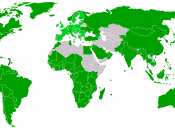Trade Barriers
The aim of every government in the world is to maximize their wealth, whether this is done to achieve a good standard of living for their people or to make the rich minority even richer is not relevant to this paper. The best and easiest way in which to achieve is to have prosperous national industries. However, in order to allow these national industries to prosper, governments are faced with the dilemma of implementing either protectionist or free trade policies. If they choose to go with the former, then they will have to impose all sorts of import restrictions, while if they choose the latter they must liberalize their markets. As with everything in life there is no black and white solution, as there are advantages and disadvantages to both choices, and there is an array of possibilities between trade policies that completely abides to the rules of free market, and a self sufficient policy where there is almost no interaction with the world market.
This paper will aim to look at the different options a government might take in greater detail, as well as how the policies taken can influence the economic growth of a country. More specifically, the paper will focus on the protectionist measures that can be implemented. This will be done by paying particular attention to the two main forms of trade barriers, namely tariff and non-tariff barriers, and the effect which they have on trade.
After the Second World War there was a widespread liberalization of the markets, which led to generalized economic growth. There was an unfailing attempt by industrialized nations to try and regulate the international trade system. This was made easier by the emergence of a global system of rules that governed the international market and were embodied by the...


